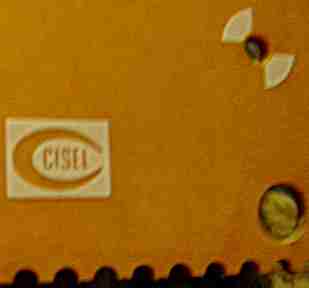|
|
This is the likely smallest Bontempi "System 5" keyboard. It is 4 note polyphonic and has each only 15 sounds and rhythms with single finger accompaniment. This thing features some nice howling digital lo-fi synth sounds and its special feature is the "auto harmonizer", which is an arpeggio- like accompaniment voice that follows held main voice notes. The trancey accompaniment is especially nice for newage, reggae and dreamy ambient musics.
This instrument was also released as Bontempi BT 204 (with pink instead of blue writing) and BT 604 (yellow panel). A pink variant with more rounded case sides was released as Barbie by Bontempi ET 2074.
 |
 |
 |
 |
 Note
the DAC- & key matrix resistor arrays. Note
the DAC- & key matrix resistor arrays. |
Attention: After dismantling this instrument, it can be only successfully re-assembled in a zero- gravity environment ;-) because always either the plastic buttons or the PCB falls out depending on its actual position. To prevent this, use a strip of adhesive film from outside to hold the buttons in place while closing the case.
The preset sounds are relatively complex, but sound rather harsh, thin and a bit noisy. They seem to be made each from 2 layered waveform samples with complex envelopes and some contain a chorus effect. This was likely a predecessor of the Bontempi GT 509 sound hardware and has many sound similarities with Bontempi BS 2010. The "electric piano" has vibrato and resembles an FM piano sound. "honky tonk" has additionally a detuned chorus. "fantasy" sounds like a bright vibraphone layered with a wooden organ pipe; the vibrato turns very slow with low notes. The organ pipe has slow attack rate, thus with short notes only the vibraphone is audible. The "synth guitar" is a somewhat voice- like and sitar- like chorus timbre that howls with about 4Hz and fades silent. It also resembles "fantasy" on Casio SA-1. The "mandolin" rings. "jazz organ" sounds like a metal pipe organ rank chord with fast attack rate and chorus. The "accordion" has chorus and turns harsh with high notes. "clarinet" and "flute" have weak vibrato (about 5Hz); flute has a quite grainy bass range. "brass" is a nice brass ensemble that turns first brighter and then dull; only a tuba(?) with vibrato stays audible with held notes. "carillon" resembles a bright Rhodes piano (timbre like metal organ pipes). "space piano" is a dull guitar (having sustain) layer with a synth violin (or theremin timbre) that has fast howling vibrato and slowly fades silent; the violin subvoice has a slow attack rate and no sustain, thus with short notes only the guitar is audible. "ghost" is a synth sound mixed from a fast (10Hz?) and a slow (4Hz) howling timbre that slowly fades silent. (Both howl by about 1 semitone.) "oriental" sounds like a bright glockenspiel layered with a tone that has fast howling detuned vibrato and fades silent (sounds Chinese). "synth harpsi" is a harpsichord sound with vibrato (bass range resembles an accordion). Selecting a rhythm always selects a corresponding preset sound, which disturbs live play.
During rhythms the first 6 keys are used to play single finger chords. The chords can be assigned to them by pressing "function" + "rec.". The LED starts to flash and you can now play normal single finger chord (organ timbre) in the right keyboard section - press simultaneously any of the leftmost keys ("1" to "6") to assign the current chord to it. Press "rec." again or start a rhythm with "start/ stop" to end this mode. There is no manual chord mode (beside the programming mode), thus chords can be only used with the rhythm accompaniments. A strange glitch of this instrument mutes the accompaniment voice for a fraction of a second when a new chord is selected, thus you can musically chop the accompaniment by trilling notes in the accompaniment section (which sounds a bit breakbeat- like). The low- res sample percussion sounds quite thin and rhythms can not be played without accompaniment.
The accompaniments sound quite cheesy and somewhat remind to reggae music. When enabled, the "auto harmonizer" feature adds after about 0.5s a wonderful sort- of arpeggio pattern to any long held melody notes. The pattern depends on the selected rhythm and can not be played with rhythm off. Although this is a simple feature, in combination with the cheesy synth sounds you can play very nice newage or dreamy ambient musics with this thing. (A more versatile variant of this idea exists also in Kawai keyboards like Kawai MS20 or MS720.)
A possibly direct predecessor of this instrument was the Bontempi
Concertino 32S. If you like the main voice sound of the ET-202,
also watch out for the Bontempi BS 2010
or (better) KE 3860,
those are based on the same sound engine and include a primitive synthesizer
for far more sound variations. (Unfortunately these are maximum 2 note
polyphonic and have annoying polyphony flaws. They also have no "auto harmonizer"
and only fixed- key accompaniments.) A more versatile (but a bit differently
sounding) successor of the ET 202 was the
Bontempi
GT 509. A GT-509 variant without drumpads and case shaped like
ET-202 was released as Bontempi BT 604/N.
| removal of these screws voids warranty... | ||
 |
||
|
|